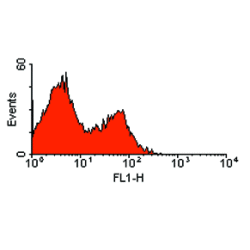ART2.2 antibody | Nika102

Rat anti Mouse ART2.2
- Product Type
- Monoclonal Antibody
- Clone
- Nika102
- Isotype
- IgG2a
- Specificity
- ART2.2
| Rat anti Mouse ART2.2 antibody, clone Nika102 recognizes the gene product of the mouse ADP-ribosyltransferase (ART) 2.2 gene, an ortholog of rat RT6. ART2.2 expressed exclusively by mature T-cells. Levels of ART2.2 expression vary between inbred strains of mice and is absent in NZW mice, in which the ART2.2 gene is deleted (Koch-Nolte et al. 1999). |
- Target Species
- Mouse
- Product Form
- Purified IgG - liquid
- Preparation
- Purified IgG prepared by affinity chromatography on Protein G from tissue culture supernatant
- Buffer Solution
- Phosphate buffered saline
- Preservative Stabilisers
- 0.09% sodium azide (NaN3)
- Carrier Free
- Yes
- Immunogen
- pME.CD8LF-ART2.2
- Approx. Protein Concentrations
- IgG concentration 1.0mg/ml
- Fusion Partners
- Spleen cells from immunized wistar rats were fused with cells of the Sp2/0 mouse myeloma cell line.
- Regulatory
- For research purposes only
- Guarantee
- 12 months from date of despatch
Avoid repeated freezing and thawing as this may denature the antibody. Storage in frost-free freezers is not recommended.
| Application Name | Verified | Min Dilution | Max Dilution |
|---|---|---|---|
| Flow Cytometry | |||
| Immunoprecipitation |
- Flow Cytometry
- Use 10μl of the suggested working dilution to label 106 cells in 100μl
| Description | Product Code | Applications | Pack Size | List Price | Your Price | Quantity | |
|---|---|---|---|---|---|---|---|
| Rat IgG2a Negative Control | MCA1212 | E F | 1 ml |
|
Log in | ||
| List Price | Your Price | ||||||
|
|
Log in | ||||||
| Description | Rat IgG2a Negative Control | ||||||
Source Reference
-
Koch-Nolte, F. et al. (1999) A new monoclonal antibody detects a developmentally regulated mouse ecto-ADP-ribosyltransferase on T cells: subset distribution, inbred strain variation, and modulation upon T cell activation.
J Immunol. 163 (11): 6014-22.
References for ART2.2 antibody
-
Kahl, S. et al. (2000) Metalloprotease-mediated shedding of enzymatically active mouse ecto-ADP-ribosyltransferase ART2.2 upon T cell activation.
J Immunol. 165:4463-9. -
Adriouch, S. et al. (2001) Rapid induction of naive T cell apoptosis by ecto-nicotinamide adenine dinucleotide: requirement for mono(ADP-ribosyl)transferase 2 and a downstream effector.
J Immunol. 167:196-203 -
Ablamunits, V. et al. (2001) Changing patterns of cell surface mono (ADP-ribosyl) transferase antigen ART2.2 on resting versus cytopathically-activated T cells in NOD/Lt mice.
Diabetologia. 44 (7): 848-58. -
Adriouch, S. et al. (2007) NAD+ released during inflammation participates in T cell homeostasis by inducing ART2-mediated death of naive T cells in vivo.
J Immunol. 179 (1): 186-94. -
Heiss K et al. (2008) High sensitivity of intestinal CD8+ T cells to nucleotides indicates P2X7 as a regulator for intestinal T cell responses.
J Immunol. 181 (6): 3861-9. -
Menzel, S. et al. (2015) Nucleotide-Induced Membrane-Proximal Proteolysis Controls the Substrate Specificity of T Cell Ecto-ADP-Ribosyltransferase ARTC2.2.
J Immunol. 195 (5): 2057-66.
- RRID
- AB_2258718
- UniProt
- O35975
- Entrez Gene
- Art2b
- GO Terms
- GO:0003956 NAD(P)+-protein-arginine ADP-ribosyltransferase activity
- GO:0031225 anchored to membrane
- GO:0018120 peptidyl-arginine ADP-ribosylation
- GO:0019897 extrinsic to plasma membrane
- GO:0051789 response to protein stimulus
MCA1975
If you cannot find the batch/lot you are looking for please contact our technical support team for assistance.
Please Note: All Products are "FOR RESEARCH PURPOSES ONLY"
View all Anti-Mouse ProductsAlways be the first to know.
When we launch new products and resources to help you achieve more in the lab.
Yes, sign me up